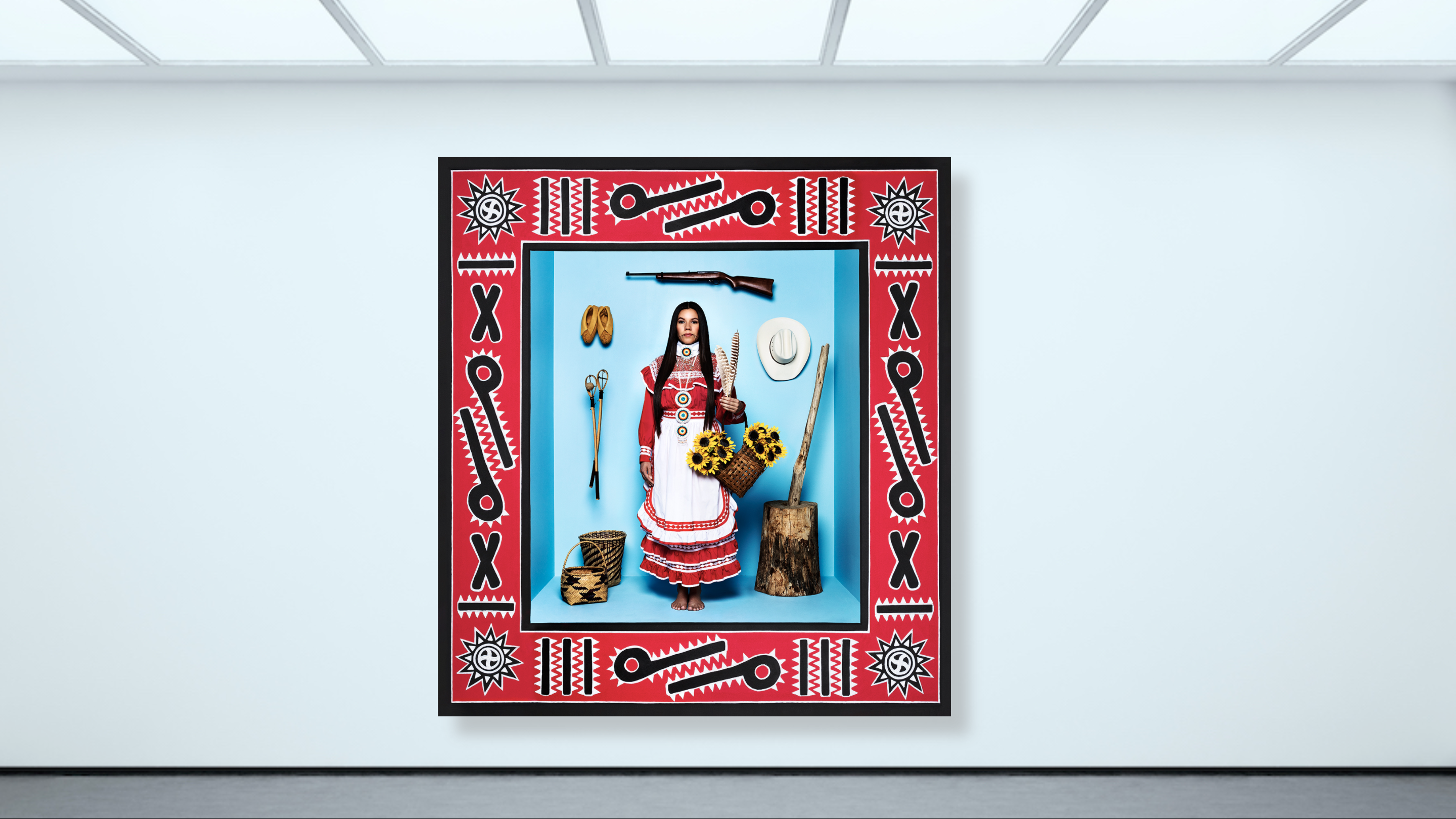
- Details
- By Tamara Ikenberg
SANTA FE, N.M.-- The ‘dolls’ depicted in Cara Romero’s First American Girl portrait series are fantastic, and they’re anything but plastic.
They’re flesh-and-blood Native American women photographed in life-size doll boxes that are packed with personal accessories from backup moccasins to blue corn. They crackle with eye-candy colors.
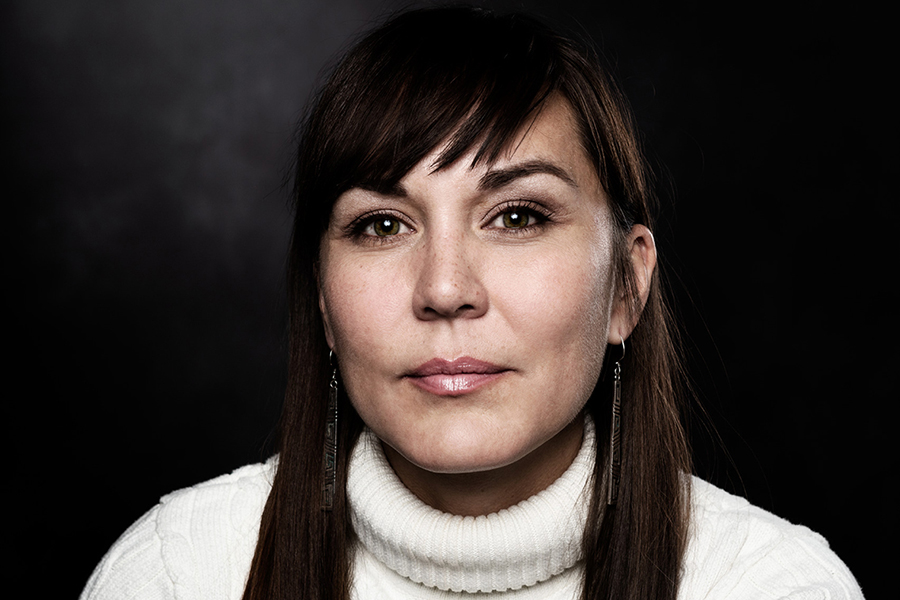 Chemehuevi photographer Cara Romero, seen here in a self-portrait, has been featured in Vogue, and is one of the hottest artists at this year's Santa Fe Indian Market.“I’m really known for my use of color. It’s supposed to scream psychologically that these are modern native women. The First American Girl series is an examination of past misrepresentation of indigenous women as dolls, and it's meant to reclaim an identity,” said Romero, who grew up on the Chemehuevi Valley Indian Reservation in Southern California, and currently lives in Santa Fe. “It was a conscious decision to make sure not everything looks historic, so that psychologically when people see them they immediately understand these are modern contemporary peoples, and living peoples. It’s not a photogravure from the 1850s.”
Chemehuevi photographer Cara Romero, seen here in a self-portrait, has been featured in Vogue, and is one of the hottest artists at this year's Santa Fe Indian Market.“I’m really known for my use of color. It’s supposed to scream psychologically that these are modern native women. The First American Girl series is an examination of past misrepresentation of indigenous women as dolls, and it's meant to reclaim an identity,” said Romero, who grew up on the Chemehuevi Valley Indian Reservation in Southern California, and currently lives in Santa Fe. “It was a conscious decision to make sure not everything looks historic, so that psychologically when people see them they immediately understand these are modern contemporary peoples, and living peoples. It’s not a photogravure from the 1850s.”
So far, there are four First American Girl portraits in the ongoing series Romero started in 2015, and they are placed in museums including the Museum of World Cultures in Rotterdam, Netherlands and The Autry Museum of The American West in Los Angeles. But you don’t have to be a curator to procure the pictures. Romero sells small, medium and large limited edition prints through her website, starting at $375.
Romero’s dramatic images, which balance pop culture sensibility and cultural sensitivity, have landed her in Vogue. Earlier this month, the magazine named her one of “8 Artists to Know From This Year’s Virtual Santa Fe Indian Market,” and lauded her “arresting photographs rooted in current events and issues within the Indigenous community.”
Romero is also the recipient of myriad awards and honors, including The Institute of American Indian Arts Distinguished Alumni Awards, and numerous top prizes in photography from major shows including the Heard Museum Indian Guild Indian Fair and Market and The Santa Fe Indian Market.
Throughout her colorful and charmed career, Romero has cultivated fans in high art places.
Kim Peone, director of the Southwestern Association for Indian Arts (SWAIA), which runs the Santa Fe Indian Market, is one of them.
“What I love about Cara is she is very thoughtful about who she is as an artist, and who she is as a representation for other Native Americans, and she transfers that into her work,” Peone said. “There’s depth there. There’s a real sense of history even and really wanting to move away from our stereotypes.”
Peone and Romero focused on more of the photographer’s work during a Coffee With Kim interview for the SWAIA website.
Peone was drawn into the emotional depth of Romero’s “Water Memories” series, which the artist describes as “photography dreamscapes dealing with Native American relationships to water, the forces of man and of Mother Nature.”
In the series’ title image, two submerged Native Americans float gracefully and naturally in a fluidly lighted drowned world that seems to stand still. “Terrifying and peaceful” is how Romero explains the effect, and it’s apt.
“To me, those were very profound,” Peone said. I come from an area where our indigenous lands were affected by hydroelectric power as well, and I didn’t know that until I had the opportunity to talk to her.”
Coffee with Kim and Cara Romero from Santa Fe Indian Market on Vimeo.
Romero applied that stereotype-defying quality to The First American Girl photos.
The series is her intricate and inspired response to what she saw as a dearth of conscientiously crafted Indian girl dolls.
“When we had a daughter of our own is when we really noticed the paucity of diversity with American Girl dolls. They have one American Girl doll that's a Native American,” Romero said. “Or at a truck stop, those dolls are always wildly offensive. There is never any detail in the regalia, no attention and love to the details, no acknowledgement of more than 250 tribes. They’re these kinds of failures.”
Thinking outside the doll box, the funky and philosophical photographer decided to recast those junky, generic playthings as very particular pictures of Indigenous power, vitality and value.
She formulated an ambitious plan: build a 7’ by 6’½’’ living doll box that can be taken apart, stored, and re-painted and designed to tell each subject’s story, and find fabulous modern Native women posing as culture bearers with their own everyday items and cherished accessories, to fill them.
“They kind of became these museum dioramas that express so much more than just what a (typical) Native American doll would look like,” Romero said. “They have this big sense of love about how we rig our daughters and how that is an intergenerational endeavor, and our different placement of wealth or value upon the items and the accoutrements that are in the boxes.”
Without further ado, meet The First American Girls:
Plains, not simple
The most common disappointing dolls Romero said she found over the years tended to be lazy takes on Plains Indians. “That's the quick go-to, and they don’t even get those right,” she said. “I thought I would try to at least get one right.”
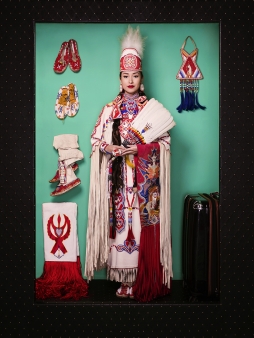 Wakeah, a Kiowa/Comanche woman, is featured Romero's First American Girl series. To realize her vision, Romero called on her colleague and friend, the Kiowa and Comanche artist and dancer Wakeah, to pose as her first First American Girl. Dance regalia is central to the subject’s identity, and Romero photographed her in a dazzling traditional southern buckskin ensemble that took five of her family members more than a year to create.
Wakeah, a Kiowa/Comanche woman, is featured Romero's First American Girl series. To realize her vision, Romero called on her colleague and friend, the Kiowa and Comanche artist and dancer Wakeah, to pose as her first First American Girl. Dance regalia is central to the subject’s identity, and Romero photographed her in a dazzling traditional southern buckskin ensemble that took five of her family members more than a year to create.
Like every subject in the series, Wakeah selected the treasured and essential items adorning the box. “I placed her accessories around her to show off the beauty and accurate detail of her regalia,” Romero said.
The striking model and her crimson beaded and fringed accessories against a cool turquoise background, make for a glorious and glamorous scene. “The high fashion lighting is not just meant to make her look right off the runway, but also for the viewer to fully embrace the high fashion masterpiece of her regalia,” Romero said.
The variety and value of Wakeah’s footwear is also emphasized. ”She’s not only got her moccasins on, but her backup pairs are on the wall.” Once the portrait was complete, Romero was assured her first dive into pro-detail Indigeneous doll design was a winner.
“It was so well-received, and everybody was asking, 'Will you do this with my tribe? Will you photograph my daughter?'" Romero said. “It was really the community that drove it to become a series.”
Amber Get Your Gun
Most parents would undoubtedly go ballistic if they spied even a toy firearm among an American Girl’s accessories. But most dolls aren’t like Amber Morningstar Byars.
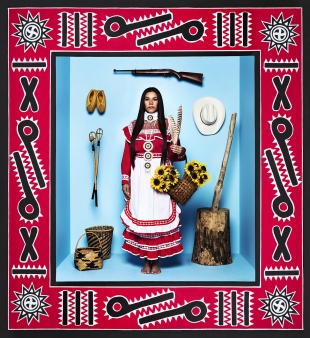 Amber Morningstar, a Choctaw woman.Romero’s Choctaw model reached for her rifle when picking and choosing the items that define her. “She wanted her favorite cowboy hat and her gun, which is very true to her upbringing,” Romero said.
Amber Morningstar, a Choctaw woman.Romero’s Choctaw model reached for her rifle when picking and choosing the items that define her. “She wanted her favorite cowboy hat and her gun, which is very true to her upbringing,” Romero said.
Amber Morningstar, a celebrated stone sculptor and now a law student, was photographed in her ribbon dress. She is placed amidst personal accoutrements that are both functional art pieces and everyday essentials, including river-cane baskets, pucker toe moccasins, kiti/kitapi (corn grinder), and her gear for the Choctaw national sport of ishtaboli (stickball).
Romero said the most time-consuming element of this First American Girl installment was dolling up the box. “We spent days and nights creating a life size box in the style of the Choctaw Nation’s beaded sashes,” she said.
Daughter of the Pueblo
The entire First American Girl experience is an intergenerational celebration.
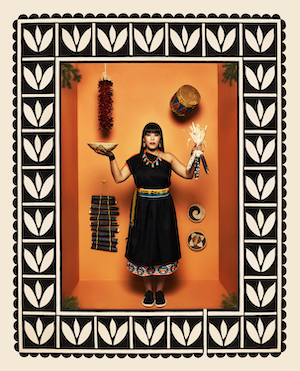 Julia, a Cochiti/San Ildefonso Pueblo woman.In Romero’s image of Julia Romero, who is of Cochiti Pueblo, San Ildefonso Pueblo and Santa Clara Pueblo descent, that connection comes through in shades of orange and blue.
Julia, a Cochiti/San Ildefonso Pueblo woman.In Romero’s image of Julia Romero, who is of Cochiti Pueblo, San Ildefonso Pueblo and Santa Clara Pueblo descent, that connection comes through in shades of orange and blue.
“Sometimes their mom helps, or grandmas donate items from their walls,” Romero said of the process of gathering accessories for the photos.
In the Julia portrait, “that’s grandma’s blue corn on the wall, and grandma’s baskets from her kitchen,” Romero said. Julia’s great grandfather is also a presence in the picture, and is represented by his Cochitli drum. Adding a touch of traditional native nourishment, hand-painted Cochiti wild spinach designs by Southwest contemporary artist Daniel McCoy freshly frame the scene.
Pines and Symbols
From her basket hat to her bare toes, Naomi is a model modern Northern Chumash woman. “In California, we dance without our shoes on, so it's more appropriate for her to be barefoot when she’s in her dance regalia,” Romero said.
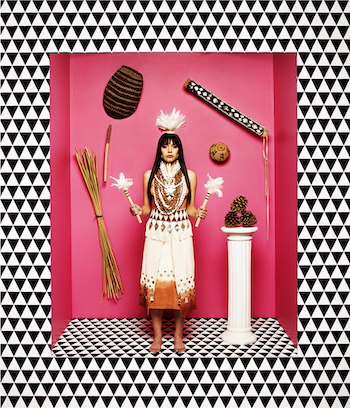 Naomi, a Northern Chumash woman. Nuance and symbolism surround Naomi, who is the daughter of a famous California regalia maker. To her right, the pinecones on a pedestal reflect the item’s high status in Chumash culture, and the black and white triangular patterns on the doll box frame reference a pinecone scale pattern commonly found in Chumash beadwork.
Naomi, a Northern Chumash woman. Nuance and symbolism surround Naomi, who is the daughter of a famous California regalia maker. To her right, the pinecones on a pedestal reflect the item’s high status in Chumash culture, and the black and white triangular patterns on the doll box frame reference a pinecone scale pattern commonly found in Chumash beadwork.
Romero painted the shocking pink background with the Golden State in mind.
“That black-and-white pattern and the hot pink makes it modern California,” Romero said. Naomi’s dress, which is adorned with abalone, and her necklaces of pine nuts, olivella snails, abalone, and clamshells, are a wearable tribute to the regional natural materials used by her Tribe since time immemorial.
“If you were to look at the entire series you would see how regalia differs from bioregion, to bioregion, using the cultural precious items from their local areas to create an adornment for dance and ceremony,” Romero said. “Naomi is also a celebration of traditions that have been passed through the centuries and millennia.”
Photo Credits: All First American Doll photos and self-portrait are courtesy of Cara Romero.
More Stories Like This
Vision Maker Media Honors MacDonald Siblings With 2025 Frank Blythe AwardFirst Tribally Owned Gallery in Tulsa Debuts ‘Mvskokvlke: Road of Strength’
Zuni Youth Enrichment Project and Partners at Ho’n A:wan Productions Launch 8th Annual Delapna:we Project
Chickasaw Holiday Art Market Returns to Sulphur on Dec. 6
Center for Native Futures Hosts Third Mound Summit on Contemporary Native Arts
Help us defend tribal sovereignty.
At Native News Online, our mission is rooted in telling the stories that strengthen sovereignty and uplift Indigenous voices — not just at year’s end, but every single day.
Because of your generosity last year, we were able to keep our reporters on the ground in tribal communities, at national gatherings and in the halls of Congress — covering the issues that matter most to Indian Country: sovereignty, culture, education, health and economic opportunity.
That support sustained us through a tough year in 2025. Now, as we look to the year ahead, we need your help right now to ensure warrior journalism remains strong — reporting that defends tribal sovereignty, amplifies Native truth, and holds power accountable.
 The stakes couldn't be higher. Your support keeps Native voices heard, Native stories told and Native sovereignty defended.
The stakes couldn't be higher. Your support keeps Native voices heard, Native stories told and Native sovereignty defended.
Stand with Warrior Journalism today.
Levi Rickert (Potawatomi), Editor & Publisher

